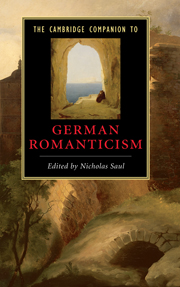Book contents
- Frontmatter
- 1 What is Romanticism, and where did it come from?
- 2 From early to late Romanticism
- 3 Prose fiction of the German Romantics
- 4 The Romantic lyric
- 5 The Romantic drama
- 6 Forms and objectives of Romantic criticism
- 7 Romanticism and Classicism
- 8 Women writers and Romanticism
- 9 The Romantics and other cultures
- 10 Love, death and Liebestod in German Romanticism
- 11 Romantic philosophy and religion
- 12 Romantic politics and society
- 13 Romantic science and psychology
- 14 German Romantic painters
- 15 Romanticism and music
- 16 Transformations of German Romanticism 1830-2000
- Key authors and their works
- Further reading
- Index
8 - Women writers and Romanticism
Published online by Cambridge University Press: 28 September 2010
- Frontmatter
- 1 What is Romanticism, and where did it come from?
- 2 From early to late Romanticism
- 3 Prose fiction of the German Romantics
- 4 The Romantic lyric
- 5 The Romantic drama
- 6 Forms and objectives of Romantic criticism
- 7 Romanticism and Classicism
- 8 Women writers and Romanticism
- 9 The Romantics and other cultures
- 10 Love, death and Liebestod in German Romanticism
- 11 Romantic philosophy and religion
- 12 Romantic politics and society
- 13 Romantic science and psychology
- 14 German Romantic painters
- 15 Romanticism and music
- 16 Transformations of German Romanticism 1830-2000
- Key authors and their works
- Further reading
- Index
Summary
Anyone concerned to discover the truth about women writers in Germany around 1800 needs to resolve some thorny problems of literary historiography. If, for example, one takes the five women portrayed by Margarete Susman in her influential volume Schriftstellerinnen der Romantik (1929; Women Writers of Romanticism) - Caroline Schlegel (1763-1805), Dorothea Schlegel (1763-1839), Rahel Varnhagen (1771-1833), Karoline von Günderrode (1780-1806) and Bettine von Arnim (1785-1859) - there is no doubt that they have many features in common. All five were born within twenty years of one another, and their careers more or less overlapped with those of the male Romantics. But these women, unlike the men, belonged to no school or group with a defined literary programme. Nor did they think of themselves in that way. Although all these women were linked with the leading literary circles of the day, their actual relationships were wholly individual, mainly of a deeply personal character, and only rarely did they include the literary activities of the other women. Some were linked by friendship, like Bettine von Arnim and Karoline von Günderrode or Dorothea Schlegel, Henriette Herz and Rahel Varnhagen. But some were bound only by critical distance or even total rejection. If one then includes other women writers and publicists around 1800 - Benedikte Naubert (1756-1819), Philippine Gatterer (1756-1831), Henriette Herz (1764-1847), Therese Huber (1764-1828), Margarete Forkel (1765-1856), Johanna Schopenhauer (1766-1838), Sophie Mereau (1770- 1806), Caroline de la Motte-Fouqué (1773-1831) and Wilhelmine von Chézy (1783-1856) - the picture becomes still more confusing, and attempts to discern meaningful groupings still more problematic.
- Type
- Chapter
- Information
- The Cambridge Companion to German Romanticism , pp. 133 - 146Publisher: Cambridge University PressPrint publication year: 2009
- 2
- Cited by

